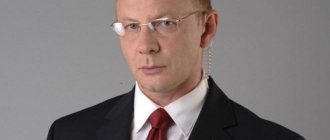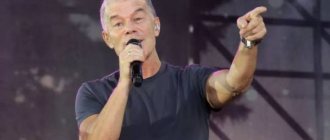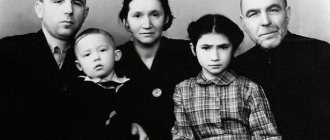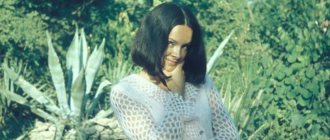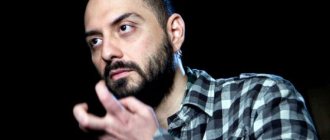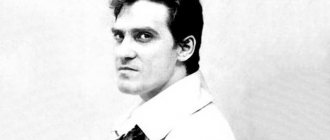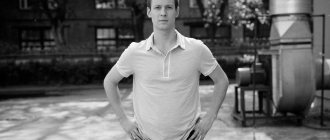Childhood and youth
The future poet and artist was born on February 25, 1814. This event took place in the village of Morintsy, located in the Kyiv province.
Taras's parents are simple serfs of Prince Potemkin's nephew, Senator Vasily Engelhardt. Grigory Ivanovich Shevchenko, the boy's father, was often not at home because he was crazy - he took the master's wheat to cities like Kyiv and Odessa to sell. Taras’s mother, Katerina Yakimovna Boyko, worked all day long in the master’s fields. That is why the grandfather and elder sister Ekaterina were involved in raising the future poet.
In 1816, the Shevchenko family moved to Kirillovka, a village that years later would be named after the poet. Taras spends his childhood in Kirillovka and meets his first love Oksana Kovalenko.
House of Grigory Ivanovich and Katerina Yakimovna. Drawing by Taras Shevchenko
In 1823, due to increased stress, Katerina Yakimovna dies. In the same year, Taras’s father marries the widow Oksana Tereshchenko for the second time, and she and her three children move into Shevchenko’s house. The stepmother immediately disliked Taras, so the boy sought protection from his older sister, and after the death of his father in 1825, he decided to leave home completely.
From 1826 to 1829, Taras wandered and worked part-time wherever possible. The first place of serious work is the parish school of clerk Pavel Ruban. It is in it that Shevchenko gets acquainted with the basics of reading and writing. The next place of work is the community of clerks-icon painters - from them Taras learns the basics of drawing. In addition to such work, Shevchenko sometimes has to herd sheep, harvest crops and help old people with firewood for the stove.
In 1829, she got a job as a servant for the new landowner - Pavel Vasilyevich Engelhardt. At first he works as a cook, and then becomes a personal assistant to Sofia Grigorievna Engelhardt, who teaches Taras French. In his free time from work, the boy continues to draw.
One day Sofia Engelhardt saw these drawings and immediately showed them to her husband. He appreciated the boy’s talent, figured that he could make a good personal painter and sent Taras to Vilna University. The boy's mentor becomes the popular portrait painter Jan Rustem.
Self-portrait of Taras Shevchenko
A year and a half later, Engelhardt sent Shevchenko to St. Petersburg to broaden his horizons and study with the local masters. In 1831, under the leadership of Vasily Shiryaev, Taras took part in the painting of the Bolshoi Theater.
Five years later, a significant event for Shevchenko takes place in the Summer Garden - an acquaintance with fellow countryman, teacher Ivan Soshenko, who brings Taras into the world, introducing him to the poet Vasily Zhukovsky, the artist Karl Bryullov and one of the leaders of the Imperial Academy of Arts Vasily Grigorovich. They sympathize with the young man and recognize his artistic talent, so they try in every possible way to help resolve the issue of ransoming Taras from Engelhardt.
But the landowner doesn’t want to just let Shevchenko go, because he has already invested so much money in this boy. The negotiations drag on for a long time and it is already beginning to seem that the ransom is impossible, but Soshenko comes up with a brilliant idea. The essence of the idea is to organize a lottery in which a portrait of Zhukovsky, painted by Bryullov, will be drawn. The winner receives a portrait, and all proceeds will go to Shevchenko’s ransom.
The lottery took place in the Anichkov Palace. Count Mikhail Velgursky helped organize this event. There were quite a lot of people who wanted to win the portrait; a total of 2,500 rubles were raised. This entire amount was transferred on April 22, 1838 to Engelhardt. Shevchenko was no longer a serf. His first decision is to enter the Academy of Arts.
“I live, I study, I don’t bow to anyone and I’m not afraid of anyone except God - it’s a great happiness to be a free person: you do what you want, and no one will stop you,” Shevchenko writes in his diary about those times.
Childhood
Taras was born on March 9, 1814. In the Zvenigorod district of the Kyiv province at that time there was a small village of Morintsy. The landowner V.V. was in charge there. Engelhardt, who was the nephew of Prince Potemkin and inherited most of his Little Russian lands. The serf peasant Shevchenko, Grigory Ivanovich, the father of the future poet, worked for this landowner.
The Shevchenko family had many children. On the paternal side, the roots went to the Zaporozhye Cossacks. Mother, Boyko Katerina Yakimovna, was from a Carpathian family. In 1816, the family moved to another village in the Zvenigorod district, Kirilovka, where Taras spent his childhood.
When Taras was 9 years old, his mother died. It was not easy for the father of a large family, and that same year he married a widow with three children. The stepmother was harsh, so little Taras was largely in the care of his sister Katya. But soon she got married, and the boy again lost his tenderness and kindness. Taras was only 11 years old when his father died. The child became homeless, and one of the most difficult periods of his life began.
Literature
The period from the moment he entered the Imperial Academy of Arts until his arrest in 1847 is the most prolific for Shevchenko in literary terms. In 1840, the cult collection of his poetic works “Kobzar” was published, which was republished more than once during the poet’s lifetime. In 1842, Taras published his historical and heroic poem “Haydamaky”.
The following year, Shevchenko decides to travel around Ukraine to see old acquaintances and find inspiration for new creativity. His muses of those times were Anna Zakrevskaya and Varvara Repnina-Volkonskaya - the first was the wife of the landowner with whom Taras was visiting, and the second was a princess. After this trip, Shevchenko wrote the poem “Poplars” and the poems “Katerina” and “Heretic”.
At home, the poet’s works were greeted quite warmly, but the reaction of the capital’s critics was completely opposite - they condemned Shevchenko’s poetry for its provincial simplicity (all works were written in Ukrainian).
Painting by Taras Shevchenko “Cathedral of St. Alexandra"
In 1845, Taras again went to Ukraine to stay in Pereyaslavl (now Pereyaslav-Khmelnitsky) with an old friend, doctor Andrei Kozachkovsky. According to unconfirmed information, the poet went to improve his health. This theory is supported by Shevchenko’s “Testament” written that year. In the same year, his poems “Mercenary” and “Caucasus” were published.
After staying with Kozachkovsky, Taras gets a job as an artist for the Archaeographic Commission, right there in Pereyaslavl. His main task at that time was to make sketches of the archaeological and historical monuments of the city (Pokrovsky Cathedral, the stone cross of St. Boris, etc.).
In 1846, the poet moved to Kyiv, where he was invited by another long-time acquaintance, historian and publicist Nikolai Kostomarov. Kostomarov recruits Shevchenko into the newly formed Cyril and Methodius Brotherhood. The poet does not immediately understand that he is being drawn into a secret political organization. Awareness comes when arrests of society members begin.
It is not possible to prove Taras’s direct attachment to the brotherhood, but the persistent head of the Third Department of His Imperial Majesty’s Own Chancellery, Prince Alexei Orlov, finds Shevchenko’s poem “The Dream,” in which he sees ridicule of the government regime and a call for rebellion. As punishment, on May 30, 1847, the poet was sent to a separate Orenburg corps to perform recruit duty. Shevchenko is also prohibited from writing and drawing, which becomes a serious blow for Shevchenko.
Lifetime photo of Taras Shevchenko
The poet Zhukovsky, Count Alexei Tolstoy and Princess Varvara Repnina-Volkonskaya are trying to help Taras in every possible way. The only thing they manage to achieve is permission for Taras to write letters. In a letter to Kozachkovsky, Shevchenko forwards a poem to “Lyakham” (“Poles”), written about immigrants from Poland serving with him.
It was possible to return to artistic activity, albeit briefly, during an expedition to the Aral Sea (1848-1849). General Vladimir Afanasyevich Obruchev secretly allows Shevchenko to make drawings of the Aral coast (for a report on the expedition). But someone finds out about this and reports to management. As a result, the general receives a serious reprimand, and Shevchenko is sent to a new place, which becomes the military Novopetrovskoye fortification (now the city of Fort Shevchenko in Kazakhstan).
There is also a ban on drawing here, so Taras tries to sculpt with clay and take photographs (daguerreotypes). It didn’t work out with clay, and photography at that time was too expensive. Shevchenko begins to write again, but this time prose works in Russian - “The Artist”, “Twins” and others. An exception is the verse “Khokhly” (1851).
In 1857, after another petition from Count Fyodor Petrovich Tolstoy, the poet was released - Emperor Alexander II canceled the punishment imposed by his father Nicholas I.
Finding Freedom
Several attempts were made to free Shevchenko from serfdom. Let's talk briefly about some of them. First, Bryullov went to Engelhardt for negotiations, but to no avail. The landowner certainly wanted a ransom. Then Venetsianov went to him in order to negotiate a price. Taras Shevchenko was consoled and pleased by the care of such prominent figures of Russian art for him. However, at times he fell into despondency, sometimes even into despair. The young man cursed his lot, and the landowner’s stubbornness discouraged him.
In his autobiography, Shevchenko wrote that Zhukovsky, having previously agreed with Engelhardt, asked to paint a portrait of Bryullov in order to play this portrait in a private gallery. Bryullov agreed and soon the portrait was ready. With the help of Vielgorsky, Zhukovsky organized a lottery, and thus Shevchenko received his freedom. As a sign of deep gratitude and special respect for Vasily Andreevich, he dedicated one of his largest poetic works (“Katerina”) to this poet.
So, on April 22, 1838, Shevchenko’s freedom was purchased for 2,500 rubles. In the same year he entered the Academy of Arts. Here Shevchenko became a student of K. P. Bryullov.
Personal life
Upon release, Shevchenko thinks about starting a family. The first attempt to get married is considered to be a proposal that the poet provided to Ekaterina Piunova in writing. Before this, the poet promoted this young theater actress and hoped that she would agree, but he was mistaken. Almost nothing is known about the second attempt, except that the girl’s name was Kharita and she was a serf.
Shevchenko's third bride was also a serf. Her name was Lukerya Polusmakova. The poet invested a lot of money in her education, rented an apartment for the girl, bought food, clothes and books. Taras wanted to buy her from the landowner, but abandoned this idea after he found her in the bedroom with one of the tutors. Taras Shevchenko did not think about marriage anymore, instead he again plunged into creativity, the result of which was the “South Russian Primer” - the first of the textbooks he planned.
Lukerya Polusmakova and Varvara Repnina-Volkonskaya
Returning to the poet’s personal life, it is also worth mentioning his earlier novels. The poet’s first love was a girl from the village of Kirillovka, Oksana Kovalenko. In the forties, the poet’s mistresses were Anna Zakrevskaya (the poem “If we met again” is dedicated to her) and Varvara Repnina-Volkonskaya.
Agata Uskova
During his years of service in the Novopetrovsk fortification, Shevchenko secretly met with Agata Uskova, who was the wife of the local commandant. There is information about the poet’s other novels, but there is no reliable evidence.
Early years
He had to lead a nomadic life. I had the opportunity to serve with a clerk-teacher, where Taras learned a little reading and writing. He was hired by clerks-painters in neighboring villages who painted icons. Here Taras learned the basics of painting, although he had been interested in drawing since his earliest childhood. I had to herd sheep and serve as a driver for the local priest.
In 1829, when young Taras was already 16 years old, he entered the service of the landowner himself, and they hired him as a cook in the kitchen. By that time, the district had passed into the possession of Engelhardt’s son, Pavel Vasilyevich. He took young Shevchenko with him everywhere. While living in Vilna, the landowner noticed that the young man drew well and sent him to study with the portrait painter Jan Rustem, who taught painting at the University of Vilna. During the year and a half spent in Vilna, Taras learned a lot from the artist. And Engelhardt decided to transfer the serf Shevchenko to the position of house painter.
Death
The poet died in St. Petersburg, where he was initially buried. This happened in 1861, the day after Taras Grigorievich’s birthday. The cause of death was ascites (abdominal dropsy). It is believed that the cause of this disease was excessive consumption of alcoholic beverages, to which the poet became addicted in his youth. Rumor has it that it was he who organized the “Mochemurdiya” club, whose members got drunk and started intimate conversations about life, and at the end of the party they chose “His Most Drunkenness.”
Monument to Taras Shevchenko in Odessa
The poet’s first burial place was the Smolensk Orthodox Cemetery, but later he was reburied on Chernechya Mountain, according to the new will. Many settlements have been renamed in memory of the poet; there is a street with his name and a monument to the poet in almost every settlement in Ukraine. Even a small crater on Mercury bears his name.
The flourishing of Shevchenko's poetic talent
The best years in Taras’s life can be considered 1840-1847 (in the photo above is a self-portrait of Shevchenko, made by him in 1840). At this time his poetic talent blossomed. The biography of Taras Shevchenko is marked by the creation of many works. The first collection of poems by this poet (“Kobzar”) appeared in St. Petersburg in 1840. He marked the beginning of a new era in the history of literature of the Ukrainian people. “Haydamaky” is Shevchenko’s largest work; it appeared in 1842. Among other significant works of this period, one can note the poem “Katerina” of 1838, “Blind” of 1842, “Talentless” of 1844, “Naimichka” of 1845, as well as the drama of 1843 “Nazar Stodolya”. Political poems that appeared at this time were “The Dream” (in 1844) and “The Caucasus” (in 1845). They denounce autocracy and are imbued with a revolutionary spirit. The people’s open call to overthrow the autocracy is expressed in Shevchenko’s political testament - the poem “How I Die...” (1845).
Progress of the investigation into the life and work of Taras Grigorievich Shevchenko
Here is what the Old Believer, non-priest Qatar, writes about this:
“It’s a strange thing, my colleagues unanimously claim that access to archives about T.G. Shevchenko is strictly classified by the KGB of the USSR, as undesirable for public reading.
This is what forced me to involve specialists from the retired counterintelligence of one European country in the work.
I claim that I have seen copies of documents certified according to all the rules of the pedantic German order, which states that the beginning of Taras’ life is completely different from what we are presented with.”
Return to homeland, new arrest and last years in St. Petersburg
Shevchenko did not stay in St. Petersburg for long, from March 1858 to July 1859. Then he went back to his homeland. Taras Grigorievich had the idea of purchasing an estate above the Dnieper. He chose a beautiful place on Chernechaya Mountain. However, Shevchenko was not destined to settle here. One day he read his poems in an unfamiliar company, and the local mayor immediately notified the governor about this, saying that Shevchenko was campaigning against the authorities. Taras Grigorievich was arrested again and ordered to leave his homeland and return to St. Petersburg under the supervision of the 3rd department. A short biography of Taras Shevchenko allows us to omit the details of life in St. Petersburg, since this time turned out to be not very fruitful for him. Shevchenko, distracted by many artistic and literary acquaintances, drew and wrote little in recent years. He devoted almost all his free time from parties and dinners to engraving, his new hobby. At the same time, Shevchenko even became an academician in copper engraving. He received this title in 1860.
The main secret of the life and work of the Great Kobzar Shevchenko
Next, Bogumil Qatar reveals the main secret of Taras Grigorievich Shevchenko. She's shocking.
Taras Shevchenko was a womanizer. Apparently, he contracted syphilis in his native village during his youth. And since the Engelharts cared about the health of their serfs, they sent him away from the village to study. By the way, the real drunken father of Taras and Pavel Engelgart died of some disease, “which one is ashamed to talk about in a decent light.” So Shevchenko’s syphilis could also be hereditary.
Next, I will give the floor to Commissioner Qatar himself:
“Hereditary syphilis gave complications. Attention reader, you will now be the first to hear the diagnosis of the “Great Kobzar”, well known to Soviet historians and archivists, graded by the KGB of the USSR. I indicate its location for those who doubt it - the archive of this department in the city of Pushkin (Tsarskoye Selo) in the Leningrad Region. The man died and no law prohibits us from publishing him.
Dyslexia is a selective impairment of the ability to master reading and writing skills while maintaining overall learning ability.”
Taras Shevchenko, Qatar claims, suffered from dyslexia. And he continues:
“This type of Ukrainian politician still exists today, in modern Ukraine. This is the former secretary of the RNBO Andrei Parubiy, a participant in the Maidan... People also call him “Speech therapist”. However, they learned to treat this in Soviet times. And the scandal with certificates about the mental retardation of the boy Parubiy is proof of this.”
Cyril and Methodius Society, arrest and exile
Taras Grigorievich in 1846 entered the secret Cyril and Methodius Society. It was founded by students and teachers of Kyiv University at the end of 1845. This society consisted of young people who were interested in the development of various Slavic peoples, including the Ukrainian. Following a denunciation from a provocateur, it was discovered by the police in April 1847. 10 people who participated in it were arrested. They were accused of organizing a political society. They were all punished. Shevchenko was especially punished for the illegal poems he created. He was exiled to the Orenburg region under the strictest surveillance. In addition, Nicholas I added personally that Shevchenko should be prohibited from writing and drawing. Taras Grigorievich's first serious problems associated with alcoholism date back to this time. Shevchenko’s binges were already well known then. During the investigation into the case of the secret society, V. Belozersky, one of its members, justified Shevchenko, saying that he wrote his poems while intoxicated and did not have any daring intentions. But these testimonies did not save the poet. The biography of Taras Grigorovich Shevchenko continues in exile.
Taras Shevchenko and Ukrainian language
“The biggest step in the propaganda of the Ukrainian language, artificially created in 1794 by Ivan Kotlyarevsky, was a major hoax associated with the artificially created image of Taras Shevchenko,” says Bogumil Qatar and proves this idea step by step, from fact to fact.
Kobzar’s godfather was the aspiring Ukrainian poet Evgeniy Grebenka. He is known to the general public as the author of the words of the beloved romance “Dark Eyes.” In 1836, Grebenka published a collection of 26 fables. They were written in the Little Russian dialect. It was not spoken in Ukraine at that time. Comical fables in the comically sounding pseudo-language of Pronya Prokopovna Serkova and Svirid Petrovich Golokhvastov were a great success with the public. It was really funny.
Evgeniy Grebenka realized that this was a genuine Eldorado. Only critics clouded the prospect of quick enrichment from such works. They wrote in unison that the language is not real, and the heroes are not from the people. Like, the author made it all up, so his works are worthless.
Grebenka turned out to be not only a talented poet, but also an enterprising person. For his future works, he decided to find an author from among the people. And in the same year, 1836, the poet’s comrade, the painter Ivan Soshenko, brought the serf artist Taras Shevchenko to him. He copied statues in the St. Petersburg Summer Garden.
Soon the star of the talented Ukrainian poet Taras Shevchenko rose from the very depths of the people...


